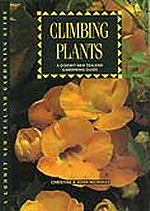
|
Climbing
Plants By Christine and John
Nicholls Reviewed
by Steve Benham, Records Officer, Auckland Regional Botanic Gardens A recent and welcome
arrival on our Botanic Garden library bookshelf is the title 'Climbing
Plants' authoritatively written by Christine and John Nicholls.
What makes this publication distinct from previous ones on the same
topic is that it has been written specifically for New Zealand gardeners
by authors who have drawn upon their 17 years of professional experience
with this group of diverse and indispensable plants. The publishers Godwit
are also to be congratulated in making this the 4th title in their
'Godwit New Zealand Gardening Guide' series. Choosing the right plant
for the right place can, and often does, prove to be a nightmare
to the novice gardener. The chapter "Plants for Places" will most
surely overcome this perennial problem and I found it to be a good
starting point when selecting the right plant for a particular aspect
and use. Not finding the deliciously fragrant Holboellia latifolia
listed under climbers with scented flowers was an obvious oversight. Basic cultural notes,
types of supports and uses are covered in the opening chapter, although
a few words of caution when planting against buildings would have
been useful. All too often amateurs and professionals alike plant
far too close to walls where and soil conditions usually prevail.
When planting frost tender plants I would advise spring planting.
Far better for the plant to die in the nursery than in ones own
garden! This guide has an excellent
layout and is easy to use, informative and on the whole scientifically
accurate, considering the complexities of taxonomic nomenclature
and the recent bout of instability. The Nicholls have obviously
a good understanding of the importance of using correct and up-to-date
nomenclature. The body of the book
is superb and is devoted to the A-Z of Climbing Plants. Each plant
entry commences with the taxonomic binomial, followed by vernacular
name in common usage, plant family, natural geographical distribution,
evergreen or deciduous, height, aspect, soil conditions and hardiness
rating. The general text for each entry is comprehensive and ends
with garden worthy infraspecific taxa, cultivars and hybrids. Clematis montana
var. wilsonii and C. montana var. rubens
have unfortunately been reduced to the cultivar status in the taxonomic
hierarchy, whereas they should be classified as botanical varieties
(see The New Royal Horticultural Society Dictionary - Index
of Garden Plants, Mark Griffiths). The same has been applied
to Jasminum affine forma grandiflora. The cultivar
'Bill Mackenzie' is not a selection of C. orientalis but
part of the Tangutica aggregate and therefore should appear as C.
(Tangutica group) 'Bill Mackenzie'. Also, C. orientalis hort.
is quite a different plant from C. orientalis Linnaeus.
The former is the commonly grown one and should be described as
Clematis tibetana subsp. vernayi. Hedera helix
cultivar 'Goldheart' is spelt as one word. Generic names derived
from Greek which end in -ma are neuter which means that
specific epithets likewise must be neuter and end in -um.
Therefore the correct spelling from the specific epithet is Schizophragma
integrifolium. The Nicholls have widely
adopted, albeit in parenthesis the Dahlgren et al. classification
of the monocotyledons. The family taxon Liliaceae has virtually
disappeared with the appearance of a number of smaller families
of more uniform content. The genera Gloriosa and Littonia
have also been split from Liliaceae and according to Dahlgren et
al. they should now be in Colchicaceae. The excellent photographs
are a great asset for identification although I only wished that
there were more, using fewer large and more smaller photographs
would have enabled a wider range to be illustrated. Eight species
of Clematis indigenous to New Zealand are listed, but no
photographs. Despite the excellent coverage of approximately 70
genera, I missed such garden worthy ones such as Actinidia,
Muehlenbeckia and Tropaeolum.
Having highlighted the few minor criticisms, I thoroughly recommend this authoritative work to both amateur and professional gardeners alike. It is a must, especially for the gardener who has run out of space on the ground and the only way to go is upwards! New Zealand Garden Journal: Journal of the Royal New Zealand Institute of Horticulture 1996 1(1): 25-26 |
Home | Journal
| Newsletter | Conferences
Awards | Join
RNZIH | RNZIH Directory | Links
© 2000–2025 Royal New Zealand Institute of Horticulture
Last updated: March 1, 2021

 BOOK
REVIEWS
BOOK
REVIEWS